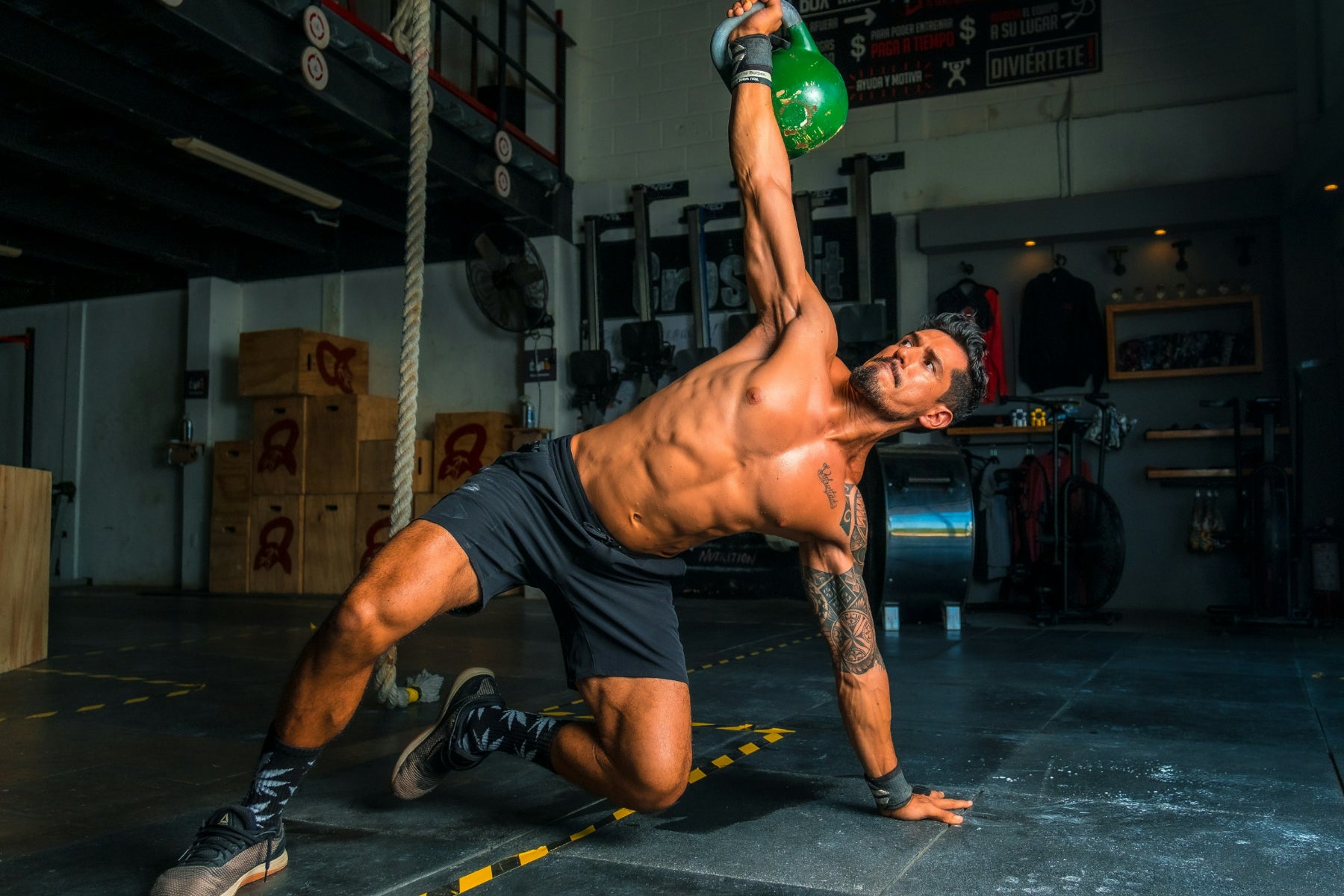Triathleten mit kleinem Zeitbudget kommen an Krafttraining nicht vorbei. Besonders im Herbst und im Winter ist die Arbeit an der Power wichtig. Denn so wird die Grundlage für eine stabile und verletzungsfreie neue Saison gelegt. Krafttraining ist jedoch erst dann effizient, wenn ihr es richtig in euer Training einbaut. So wird’s gemacht.
Warum Krafttraining
Leistung ist Arbeit pro Zeit. Arbeit wird definiert als Kraft mal Weg. Für uns Triathleten bedeutet das, wer mehr Leistung bringen will, muss bei gleichem Weg mehr Kraft aufbringen. Durch das richtige Krafttraining kann man das Kraftniveau und damit seine Leistungsfähigkeit erhöhen.
Das Ziel von Triathleten sollte sein, ein möglichst hohes Kraft-Masse-Verhältnis zu erreichen. Eine Gewichtszunahme ist in der Regel nicht sinnvoll. Viel mehr sollte erreicht werden, dass bei gleichbleibendem Körpergewicht, das Kraftniveau erhöht wird. Wer mehr Kraft hat, kann härter schwimmen, dickere Gänge fahren und auch schneller laufen.
Weitere Effekte des Krafttrainings für den Triathleten
Im Wettkampf kommt es durch mehr Kraft zu einer langsameren Ermüdung der Muskulatur. Außerdem beugt eine gut ausgebildete Muskulatur gegen Verletzungen vor und die ausführenden Bewegungen in den drei Einzeldisziplinen werden dynamischer. Ein weiterer Pluspunkt: Je besser Deine Muskulatur ausgebildet ist, umso weniger müssen Knochen, Bänder und Sehnen den Körper gerade beim Laufen abfedern und werden so geschont.
Was passiert bei schwacher Muskulatur?
Ein Läufer mit schwach ausgebildeter Muskulatur knickt bei jedem Fußkontakt mit dem Boden in der Hüfte ein. Die Laufbewegung wird dadurch unnötig abgebremst. Ein Einknicken in der Hüfte bewirkt wiederum, dass er anschließend extra Kraft aufwenden muss, um den Körper wieder aufzurichten. Erst dann kann er wieder beschleunigen.
Wer also mehr Kraft hat, knickt weniger ein, hat mehr Kraft übrig für den Vortrieb und ist definitiv schneller. Bei der Schwimm- und Raddisziplin ist der Ansatz ähnlich. Auch beim Schwimmen bedeutet eine bessere Muskulatur, dass der Athlet weniger einknickt und so besser geradeaus schwimmen kann. Typisch bei schwacher Muskulatur ist eine Schlangenbewegung der Beine, wie es oftmals der Fall ist.
Wann und wie sollte Krafttraining im Trainingsplan auftauchen?
Grundsätzlich ist Krafttraining das ganze Jahr sinnvoll, aber man sollte die Schwerpunkte an die jeweilige Trainingsperiode anpassen. Je allgemeiner das Training ist (gerade am Anfang der Trainingssaison), um so mehr Sinn ergibt der Einsatz von Gewichten in Form von Handeln oder Geräten im Fitnesscenter. Um Kraft aufzubauen, muss man ein recht intensives Krafttraining betreiben. Das ist wiederum kontraproduktiv für das andere Training, da die Regenerationszeiten relativ hoch sind und weil die Anpassung etwas länger dauert, als bei einer „einfachen“ Laufeinheit.
Im Verlauf spezifischer werden
Während im Herbst und Winter umfassendes und allgemeines Krafttraining eine gute Basis ausbildet, verändert sich das Training im neuen Jahr. Je näher der Wettkampf rückt, desto spezifischer sollte Krafttraining sein. Das heißt, es sollte direkt mit in den entsprechenden Sportarten verbunden sein. Eine Kraftausdauereinheit könnte dann so aussehen: Einen dicken Gang treten und das mit etwa 60 Umdrehungen pro Minute, mit Paddles schwimmen oder einen Laufeinheit mit Berganteilen.
Typische Vorgehensweise für eine Krafteinheit mit Gewichten (für Fortgeschrittene)
- Das Gewicht sollte 60 bis 75 Prozent der Maximalkraft betragen
- Das Gewicht sollte zügig-langsam kontrolliert bewegt werden
- Die Dauer einer Serie sollte etwa 8 bis 15 Wiederholungen und bis zur starken lokalen Erschöpfung führen, das heißt, der letzte Zug am Gewicht sollte gerade noch möglich sein.
- Die Pause zwischen den Sätzen sollte 2 bis 4 Minuten dauern
- Und insgesamt sollten es pro Übung etwa 3 bis 6 Sätze sein
Typische Vorgehensweise für eine Kraftausdauereinheit mit Gewichten
- Verbesserung der Kraftausdauer!
- Das Gewicht sollte 50 bis 60 Prozent der Maximalkraft betragen
- Das Gewicht sollte zügig bis schnell (aber kontrolliert!) dabei bewegt werden
- Die Dauer einer Serie sollte etwa 1 bis 2 Minuten dauern und bis zur lokalen Erschöpfung führen, das heißt, der letzte Zug am Gewicht sollte gerade noch möglich sein.
- Die Pause zwischen den Sätzen sollte 3 bis 10 Minuten dauern
- Und insgesamt sollten es pro Übung etwa 3 bis 5 Sätze sein
Für Fortgeschrittene: Intramuskuläre Koordination
Wer schon ein gutes Kraftausdauerniveau erreicht hat kann im weiteren Trainingsverlauf zudem versuchen seine intramuskuläre Koordination zu optimieren.
Was soll intramuskuläres Koordinationstraining bewirken?
Nehmen wir die Tretbewegung auf dem Fahrrad als Anschauung. Bei jeder Pedalumdrehung die wir machen, werden nicht immer alle Muskelfasern des Oberschenkelmuskels angesprochen, sondern immer nur ein Ausschnitt, eine bestimmte Anzahl. Bei der nächsten Umdrehung wird wieder ein anderer Teil der Oberschenkelmuskelfasern eingesetzt. Daraus ergibt sich immer wieder eine Erholung für die einzelnen Muskelfasern die gerade nicht beansprucht werden.
Das Ziel ist allerdings möglichst viele Fasern des Muskels gleichzeitig anzusprechen und dadurch ein höheres Kraftniveau bei gleicher Masse zu erreichen. Und genau dieses mobilisieren möglichst vieler Muskelfasern gleichzeitig, soll das Ziel dieser Trainingsform sein. Diese Krafttrainingsform ist allerdings nur für Fortgeschrittene gedacht, die sich schon auf einem guten Kraftniveau befinden. Zu früh angewendet kann sie schädlich für den Bewegungsapparat sein und Gelenk- oder Muskelschmerzen verursachen.
Wie sieht ein intramuskuläres Krafttraining mit Gewichten aus?
- Das Gewicht sollte 90 bis 100 Prozent der Maximalkraft betragen
- Das Gewicht sollte zügig bei explosivem Krafteinsatz bewegt werden
- Die Dauer einer Serie sollte etwa 1 bis 5 Wiederholungen sein.
- Die Pause zwischen den Sätzen sollte 3 bis 5 Minuten dauern, darf auf länger sein
- Und insgesamt sollten es pro Übung etwa 5 bis 12 Sätze sein
Fazit
- Kraftausdauertraining sollte bei jedem Triathleten und jeder Triathletin im Trainingsplan stehen.
- Krafttraining ist genauso wie Grundlagenausdauer oder Grundschnelligkeit am Anfang des Trainingsplanes oder -jahres verstärkt einzuplanen.
- Erst die allgemeine Muskulatur trainieren, dann spezifischer werden.
- Erst sollte Kraftausdauer trainiert werden und bei entsprechendem Niveau können intramuskuläre Trainingseinheiten folgen.
- Wie bei jedem Training sollte auch hier das Trainingsprogramm dem Niveau des Athleten angepasst sein, sonst kann es zu schnell zu einer Überlastung kommen.




















